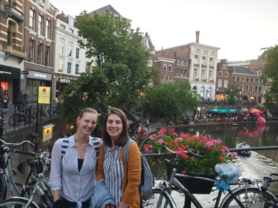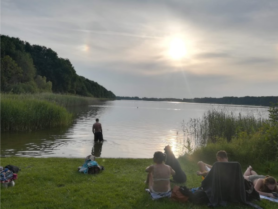Blogs
Barbara Szenasi – Secondment in the exceptionally sunny Netherlands!
Let’s start with something unusual; the Netherlands is normally not a sunny country, but it was exceptionally sunny during the four weeks of my secondment from mid-June to mid-July 2019. I would call it pure luck, some others may call it climate change. Anyway, the beautiful, not rainy, warm weather made my stay in the Netherlands even better. I travelled to Utrecht for a secondment at TNO (NetherlandsOrganisation for Applied Scientific Research), a non-academic partner of MEMO2. There, I was received with a warm welcome by the colleagues I already knew from my master thesis. As I wasn’t in a completely new environment, I knew more or less what to expect and that made it easier to focus on my tasks.

View on the Dom Tower in Utrecht
My PhD project is about modelling CH4 concentrations and deriving CH4 emission estimates by using atmospheric measurements of CH4 concentrations for Europe. More precisely, the goal of my PhD is to make a map of estimated CH4 emissions for Europe while using simple methods. But before I can do this, I have to tackle two important tasks. First, the performance of CHIMERE, the atmospheric transport model I am using to simulate CH4 concentrations, needs to be evaluated before we can start estimating emissions. Secondly, the biggest task that every further work is based on: the estimation of errors in transport models and emission inventories. These errors are essential for deriving emission estimates. And this task is the reason I went to TNO. There, another atmospheric transport model, called LOTOS-EUROS, is used for simulating the atmospheric composition of several species, including CH4.
LOTOS-EUROS basically simulates concentrations in the same way as CHIMERE, but the representation of the transport used in the two modes is slightly different. This is because they use different physical parametrizations and approximations of the same fundamental equations for atmospheric transport. This gives us a way to estimate the errors in transport models. But how can we do that? It is relatively straightforward: we compare the simulated CH4 concentrations made by the two models. It is simple, is it not? Well, it could be if we stick to some rules, such as we try to keep everything, beside the transport, the same in the two models. “Everything else” refers to using the same model grid-cell size and the same inputs; e.g. meteorology, emission inventories, boundary and initial conditions (I explained a bit more about models and errors in this blog: https://h2020-memo2.eu/2018/09/05/barbary-szenasi-my-research-visit-at-wageningen-university/). Keeping everything else the same or very similar ensures that we compute the errors of only the transport and not of the emissions, for example. We found that the transport error is the biggest error in the modelling set-up that I am currently using. However, this is an issue that is not easy to solve, and thus the only thing we can do is to take it into account when doing further modelling.

Exploring Utrecht with Mila
I feel that my work at TNO was effective and fruitful and the collaboration with the colleagues was smooth and pleasant. I received good advice that led to new ideas and we could directly discuss issues or questions concerning the comparison of the simulated concentrations of the two models which speeded up the work. Probably the walks with the colleagues in the beautiful botanical garden nearby during the lunch breaks also contributed to the productive and nice working experience. And of course all the other activities that were more enjoyable in the awesome weather: kayaking, swimming, spending time in the garden or having food and drinks outside with other MEMO2 students and my family in the Netherlands. There was also a big and fun coincidence that Mila (or otherwise known here as ESR3) was doing her secondment at the Utrecht University at the same time so that we could share an apartment. Looking back, I must say I had an amazing secondment in Utrecht.

Enjoying the Maarsseveense plassen
PS.: as someone working on the computer only, it is so hard to show nice work pictures (compared to people who can take amazing pictures during their measurement campaigns). So that is why I have pictures about my experiences outside of work. And because that looks more exciting than me sitting in front of a computer.

